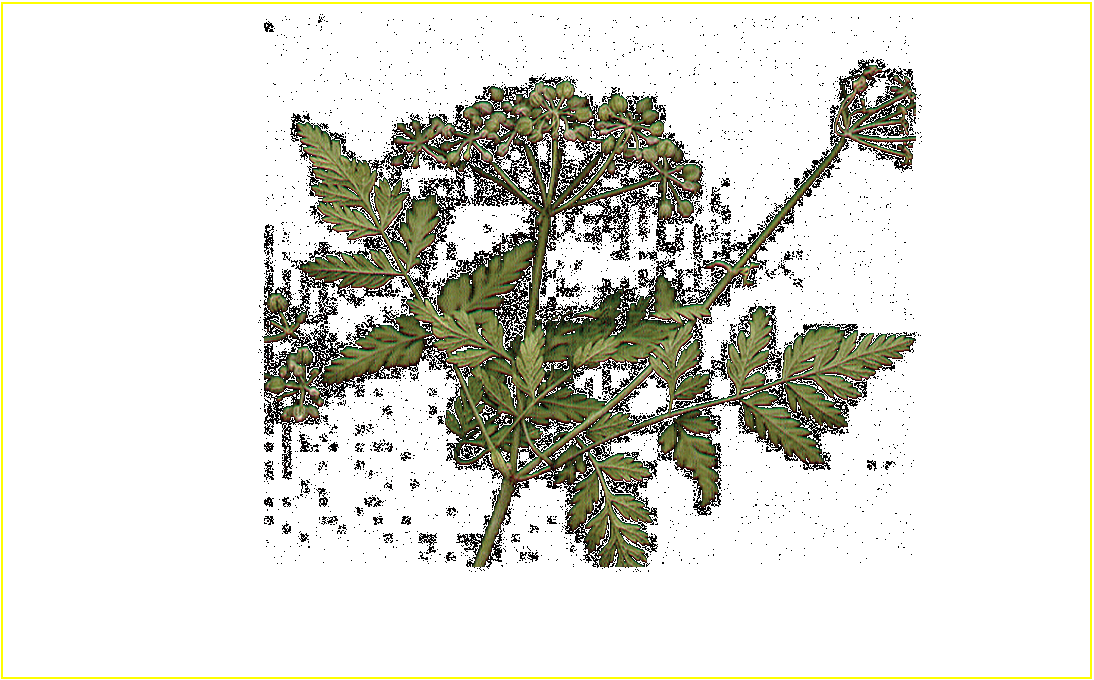The above photo shows the green immature conium seed that is most desirable for tincturing. Note that the underside veins reaches directly to the leaf tips unlike its close relative, water hemlock, which only reachs to the notches in between leaf tips. One way to tell the two apart and to avoid the water hemlock variety!
Conium Maculatum or Poison Hemlock has a mystique that goes far beyond that which is in fact the true reality of this unique plant. It has medicinal values that have been often overlooked throughout these recent ages. In these modern times, historic medical use of this plant is largely forgotten and supplanted by grave warnings of deadly toxicity to be found every where in all herbals and conventional medical texts. I suspect each feeds upon the other these fallacies. In the current and recent past literture, one author borrow from another in warning dire results of Conium Maculatum without any personal experinece on the subject. I am not saying that Conium M. should not be carefully processed or prescribed. It can be deadly, but I am saying that the good is often overlooked for the hear-say. The true facts of poison hemlock as a medicinal is that in the past, it was often quite inert in tincture form. Useless! From my research and readings, I have easily come to the conclusion that physicians of the 19th and early 20th centuries found poison hemlock medicinals often unpredictable in quality and inert in its many prescribed forms. This is to be expected! Coniine, its most potent component is quite volatile and can easily be rendered useless by improper processing and by mere storage time alone. The advertised danger is much overrated. On this page, I would like to offer you my decidedly contrarian opinion and experiences on this very interesting plant that nature has so uniquely bestowed on those that know and understand her intricacies. I know of no other herb that can offer similar medicinal properties as Conium Maculatum.
The so-called poisonous herbs have always fascinated me. I may have been slow about being awakened, but I have long considered Poison Hemlock a deserving subject for further personal herbal study. She has proven to be very worthy of my humble attentions!
From King's American Dispensatory:
Specific Indications and Uses: — To relieve nervous excitation and give rest (antispasmodic); neuralgic or rheumatic pains in the old and feeble, or where there are caco-plastic deposits; pain in stomach; pain of gastric ulcer; nervousness and restlessness. Dr. Harley found it of value in many nervous diseases, particularly children diseases. The beauty of poison hemlock is that the mind is crystal clear. It does not affect mental cognition which is most unusual when it comes to most sedatives and other similar CNS medicines. It also has the unique affect of starting in the lower legs and working slowly upwards toward the head--very useful in treating just leg conditions!
Probably one of the premier texts on Poison Hemlock as a medicinal is Dr. John Harley's The Old Vegetable Neurotics published in 1869. Dr. Harley offers valuable insight into Conium Maculatum, its affect and its medicinal value. He does make the controversial remark in this volume that he finds the succus, juice of the plant to be the most effective. Later practitioners seem to disagree with the medicinal value of the juice, but he should not be ignored. Poison Hemlock was formulated in the last century in several forms: (1) tincture of conii, (2) extract of conii, (3) Succus Conii, (4) Conium ointment, (5) Coniine Inhalation.
It is generally conceded that the most potent portion of this plant is the immature seed. Surprisingly, Dr. Harley found the tincture of the fruits to be inert. He suggests this may be caused from the traditional use of dried seed in the making of such tinctures. He found the green plant to be the highest potency. He next examined the tincture of the dried leaf in which he found the dried leaf to contain a trace of coniine, but it was much too small to be effective. He studied the succus or juice of the Hemlock. His succus was made from green plants in bloom. The extracted juice was mixed with one part alcohol to 3 parts juice and set aside in the cellar and later filtered and bottled. He would routinely prescribe adults from 2 drachms up to one ounce and found the succus' effect far superior than any of the tinctures or other forms. Harley found the extract and vapors to be ineffectual for probably the same reasons as the tinctures.
Coniine, the active ingredient of Poison Hemlock is a very unstable volatile akaloid. Thus, we have the probable reason why poison hemlock went out of favor in medical history's past. Dr. Harley found that one of the most potent forms of Hemlock was the green immature seed, ground to a pulp and mixed with a 50% solution of water/ethanol and macerated. However, none of his experimentation or formulas took into consideration that coniine could be fixed into a more stable compound. This also seems to be true of almost all of the formulations of conium maculatum listed back in the 19th century or earlier. It was hoped that coniine would stay potent in just an hydro-ethanol menstruum. Most of the time, it did not.
In later times, it was found that coniine could be fixed (stablilized) by an acid into producing a salt. Various salts, including the hydrochloride and the benzoate have been prepared from it, but the hydro-bromide is the one most frequently used. Coniine dissolves easily in acidulated water with hydrochloric acid and is miscible with alcohol. Coniine Hydrochloride is the salt of coniine which has reacted with hydrochloric acid. Coniine can react with an aqueous solution of Hydrochloric acid to produce this salt. From Remington's Practice of Pharmacy (early 20th century): you will find their "Tinctura of Conii" is made by percolating 15 parts of Conium with diluted alcohol containing a little diluted Hydrochloric acid until 100 parts is obtained.
Note that one should avoid water hemlock (Cicuta) at all costs when preparing medicinal conium maculatum. The two are very similar in appearance and could be easily confused. Generally speaking water hemlock is only found next to swampy ground or bodies of water while conium maculatum can be found in both places. Poison hemlock is sometimes confused with the water hemlocks in the related genus Cicuta, but are readily distinguished by the less finely divided leaves of the latter; the leaf veins of poison hemlock also run through the tips of the teeth, but those of the water hemlock run through the notches in between the teeth. The poison hemlock's root is long, white, and fleshy. It is unbranched and can usually be distinguished from the water hemlock's roots that are made up of several tubers.













